Sighisoara to Bucharest



Sightseeings on trip



English speaking driver



Hotel pick up / drop off



Pet not allowed



Up to 7 passengers



WiFi connection
Your trip can be made with 4 types of cars: sedan for 1 – 3 people ( ex. Volkswagen Passat or Skoda Octavia), executive (VIP) for 1-3 people (ex. Mercedes E Class or Audi A6), MPV for 1-4 people ( ex. Ford Galaxy or Volkswagen Touran) and VAN for 1-7 people ( ex. Renault Trafic or Volkswagen Transporter). If your group is bigger than 7 people we will use a combination of vehicles. Also for every trip are available a few stops at interesting sightseeings for a price between 16 – 18 Euro/h.
Optional sights for visiting on this trip



Rasnov fortress
First mentioned in an official document in 1331, the fortress was built by Teutonic Knights as protection against invading Tartars and was later enlarged by the local Saxon population. Is located on a rocky hilltop in the Carpathian Mountains, 650 ft. above the town of Rasnov. Guarded by nine towers, two bastions and a drawbridge, the fortress was only breached once, in 1612,when the Ottomans discovered the secret passage inhabitants used to sneak out to fetch water. The fortress was last used as a place of refuge during the revolution of 1848 and was abandoned after that. Recently, the old fortress has been restored to its former glory and today, you can visit the impressive remains.
First mentioned in an official document in 1331, the fortress was built by Teutonic Knights as protection against invading Tartars and was later enlarged by the local Saxon population. Is located on a rocky hilltop in the Carpathian Mountains, 650 ft. above the town of Rasnov. Guarded by nine towers, two bastions and a drawbridge, the fortress was only breached once, in 1612,when the Ottomans discovered the secret passage inhabitants used to sneak out to fetch water. The fortress was last used as a place of refuge during the revolution of 1848 and was abandoned after that. Recently, the old fortress has been restored to its former glory and today, you can visit the impressive remains.



Bran Castle
Bran Castle also known as Dracula’ Castle is situated on the Transylvanian side of the historical border with Wallachia. ‘Dracula’s Castle’ was actually founded by the Teutonic Knights in 1212, and rebuilt by the Saxons of Kronstadt in 1377. Surrounded by an aura of mystery and legend and perched high atop a 200-foot-high rock, Bran Castle owes its fame to its imposing towers and turrets as well as to the myth created around Bram Stocker’s Dracula. From 1920 to 1948 Bran served as royal residence, a gift of the people of Brasov to Queen Marie of Romania. The castle is now a museum open to tourists, displaying art and furniture collected by Queen Marie.
Bran Castle also known as Dracula’ Castle is situated on the Transylvanian side of the historical border with Wallachia. ‘Dracula’s Castle’ was actually founded by the Teutonic Knights in 1212, and rebuilt by the Saxons of Kronstadt in 1377. Surrounded by an aura of mystery and legend and perched high atop a 200-foot-high rock, Bran Castle owes its fame to its imposing towers and turrets as well as to the myth created around Bram Stocker’s Dracula. From 1920 to 1948 Bran served as royal residence, a gift of the people of Brasov to Queen Marie of Romania. The castle is now a museum open to tourists, displaying art and furniture collected by Queen Marie.



Peles Castle
In the picturesque town of Sinaia, Peles Castle is a masterpiece of German new-Renaissance architecture. Commissioned by King Carol I in 1873, the castle served as the summer residence of the royal family until 1947. King Carol’s successor, King Ferdinand built a smaller version, but equally grand. Several auxiliary buildings were built simultaneously with the castle: the guards’ chambers, the Economat Building, the Foișor hunting lodge, the royal stables, and a power plant. Peleș became the world’s first castle fully powered by locally produced electricity. Here you can admire how the furniture, art and decor change from one room to another in one of the most beautiful houses in Europe.
In the picturesque town of Sinaia, Peles Castle is a masterpiece of German new-Renaissance architecture. Commissioned by King Carol I in 1873, the castle served as the summer residence of the royal family until 1947. King Carol’s successor, King Ferdinand built a smaller version, but equally grand. Several auxiliary buildings were built simultaneously with the castle: the guards’ chambers, the Economat Building, the Foișor hunting lodge, the royal stables, and a power plant. Peleș became the world’s first castle fully powered by locally produced electricity. Here you can admire how the furniture, art and decor change from one room to another in one of the most beautiful houses in Europe.



Old salt mine Slanic Prahova
Slanic mine is an old salt mine, located in Slănic, Prahova County, Romania, just 100 km north of Bucharest. The salt mine is closed for extraction purposes, but is open for visitors, featuring a microclimate with natural air-conditioning and constant temperature and atmospheric pressure throughout the year. The constant microclimate, rich in aerosols, has made it a popular destination for people with respiratory issues. One area is sectioned off and is being used for medical patients with lung cancer to come and rest. Throughout the mine you will find various types of equipment for recreational activity such as playground equipment and some ping-pong tables.
Slanic mine is an old salt mine, located in Slănic, Prahova County, Romania, just 100 km north of Bucharest. The salt mine is closed for extraction purposes, but is open for visitors, featuring a microclimate with natural air-conditioning and constant temperature and atmospheric pressure throughout the year. The constant microclimate, rich in aerosols, has made it a popular destination for people with respiratory issues. One area is sectioned off and is being used for medical patients with lung cancer to come and rest. Throughout the mine you will find various types of equipment for recreational activity such as playground equipment and some ping-pong tables.



Snagov monastery
Hidden by woods and surrounded by the waters of the Lake Snagov, the Snagov Monastery was the most important spiritual and cultural centre of Wallachia in the feudal period. Built on an ancient place – where the archaeological finds have discovered clay pots of the Bronze Age and Iron Age, as well Roman and Byzantine coins – the monastery is one of the oldest monastic settlements. Some legends say that after the ruler Vlad Tepes was murdered in 1476 by the Wallachian boyars, the monks of the monastery would have taken the body and bury it in secret in the church.
Hidden by woods and surrounded by the waters of the Lake Snagov, the Snagov Monastery was the most important spiritual and cultural centre of Wallachia in the feudal period. Built on an ancient place – where the archaeological finds have discovered clay pots of the Bronze Age and Iron Age, as well Roman and Byzantine coins – the monastery is one of the oldest monastic settlements. Some legends say that after the ruler Vlad Tepes was murdered in 1476 by the Wallachian boyars, the monks of the monastery would have taken the body and bury it in secret in the church.
